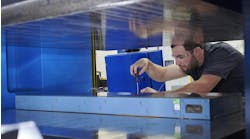This question is relevant to all hydraulic professionals, machine owners and users:
"What is the most effective and efficient method to diagnose internal leakage on mobile construction equipment; e.g Backhoe or Skid Steer Loader -- WITHOUT the aid of diagnostic tools, such as pressure gauges and flow meters."
It's not a bad question. But upon deeper analysis it smacks of 'silver-bullet' seeking. The revealing phrases are "most effective and efficient method" and "without the aid of... pressure gauges and flow meters".
It's human nature to seek maximum gain from minimum effort. Even if it's not always realistic. And since my job here is to entertain as well as inform, I'll give you my 'silver bullet' answer first:
I've developed and patented a special troubleshooting paint. So now when a hydraulic problem arises, all you have to do is shake the can well and spray any hydraulic component you suspect might be faulty. After a couple of minutes, faulty components turn red and serviceable components turn green.
It's a nice fantasy. About my early retirement I mean.
So to qualify the question before I answer it, until I perfect my magic spray paint: the most efficient method of troubleshooting may not be the most effective, and the most effective not the most efficient -- which I assume is the reason this member excluded pressure gauges and flow meters when posing the question.
But there are other tools and techniques we can employ when troubleshooting hydraulic equipment. One of these is the infrared thermometer or heat gun. The equipment required is inexpensive, its application is quick and non-invasive, and the results can be very revealing.
It's usefulness in hydraulic troubleshooting comes about because when hydraulic fluid moves from an area of high pressure to an area of low pressure (pressure drop) without performing useful work, heat is generated. For a more detailed explanation of this concept, watch this video clip.
This means hydraulic components with abnormal leakage generate abnormal heat. So a double-acting cylinder with a leaking piston seal or a relief valve that is passing, usually become hotter than the rest of the system. And an infrared thermometer will quickly reveal this to you.
But like most other tools, an infrared thermometer is only as good as the person using it. And so you do have to be careful of false positives. As I explain in The Hydraulic Troubleshooting Handbook, the objective of every troubleshooting assignemnt is to PROVE a component is faulty BEFORE it is changed-out. And this is accomplished through a logical process of elimination.
An infrared thermometer can certainly speed up this process. But if the data coming from it doesn't make sense or is not conclusive, then other diagnostic tools should be used to eliminate any doubt.
For example, a recent client came to the conclusion that a solenoid valve was the cause of his problem -- based on temperature measurement alone. But there were two problems with this diagnosis: Firstly, a solenoid valve tends to absorb heat from its coil when energized -- which could explain its temperature rise. And secondly, in the context of the particular system, this conclusion didn't really make sense.
So I explained we should note his observation but continue the troubleshooting process, using other tools as necessary, to prove the diagnosis one way or the other. Because a false positive is just as bad as a blind guess. It results in the unnecessary change-out of serviceable components. Something you want to avoid.
So while a infrared thermometer or heat gun can be your #1 hydraulic troubleshooting tool, it should not be your ONLY one!
Continue Reading
Continue Reading
Motor leakage variations
Oct. 18, 2006
Sponsored Recommendations
Sponsored Recommendations
How Variable Volume Pumps Work
Feb. 6, 2024
What is a Check Valve and How Does it Work?
Feb. 6, 2024
